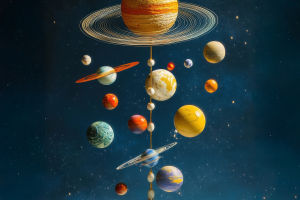When we look up at the night sky, we often feel a sense of wonder. But did you know that what we see—those countless stars—are often just a tiny part of something much bigger?
Galaxies are massive systems filled with billions of stars, star clusters, interstellar gas, cosmic dust, and even mysterious dark matter.
They're held together by gravity and often rotate slowly around a dense core. Think of our own Milky Way, home to over 100 billion stars—it’s just one of the countless galaxies out there.
How Do Galaxies Spin?
We might imagine galaxies as simple spinning wheels, but their motion is more complex. Most galaxies spin because smaller stars and planets orbit a large, heavy center—like how Earth orbits the Sun. In some galaxies, instead of one giant center, stars share a common gravitational center, orbiting together like a cosmic dance. But the first pattern, where many small objects revolve around a massive core, is far more common across the universe.
The Many Types of Galaxies
Galaxies come in all shapes and sizes. Some, like dwarf galaxies, contain just a few million stars. Others, like giant elliptical galaxies, hold trillions. But all galaxies have one thing in common—they each have a central mass that holds everything together. Besides individual stars and gas, galaxies often include twin or multiple star systems, vast star clusters, and beautiful nebulae.
The Space Between: What Lies in the Gaps
What fills the space between galaxies? It turns out there’s something called the intergalactic medium—a super thin plasma made mostly of ionized hydrogen, which means it's full of free electrons and protons. Even though it’s thin, it’s denser than the average matter in the universe, especially within massive star systems. In those dense clusters, this medium can be 1,000 times thicker than average space!
More Than 100 Billion Galaxies!
Yes, we said that right—there are over 100 billion galaxies in the observable universe. These stellar systems often group together, forming groups and clusters. And those clusters can combine into even bigger structures called superclusters. From a distance, they form thread-like patterns, rotating around massive empty spaces like cosmic webs.
The Mystery of Dark Matter and Black Holes
Dark matter makes up most of the mass in many galaxies—over 90% in some! Although we can’t see it directly, we know it's there because of its gravitational pull. And most galaxies also have supermassive black holes at their centers. These giant black holes help explain why some cosmic centers shine so brightly. Our own Milky Way is believed to have one hidden at its center.
Galaxies Vary in Size, Mass, and Speed
Galaxies range from small to absolutely massive. Small irregular galaxies can be 6,500 to 29,000 light-years across. Spiral galaxies, like ours, usually stretch 16,000 to 160,000 light-years. The biggest elliptical galaxies can be up to 490,000 light-years wide! A single star system can contain hundreds of billions of stars, with a total mass that’s 100 to 1 trillion times that of our Sun. Even more fascinating—they’re all moving, rotating, and drifting away from us, as shown by the redshift seen in cosmic background radiation. This supports the idea that the universe is expanding.
Galaxies Are Rarely Alone
Most galaxies aren't floating alone in space. They’re usually part of a group, like our Local Group, which includes the Milky Way, Andromeda, and dozens of smaller satellite galaxies. If a collection contains about 50 members, we call it a group. Larger structures, made of hundreds or thousands of these systems, are called clusters. Often, a massive elliptical system sits at the center, pulling smaller ones into itself over time.
How Did Galaxies Form?
There are two main theories about how galaxies came to be. One says galaxies were born from the same event that created the universe—the cosmic explosion, about 13.7 billion years ago. The oldest galaxies likely formed not long after that. The other theory suggests galaxies formed gradually, as globular clusters collided and broke apart, leaving behind cosmic dust that slowly gathered into vast star systems over billions of years.
The Universe's Web-Like Structure
When we zoom out to a grand scale, we find that galaxies are not randomly scattered. Instead, they form a vast web, with thread-like structures stretching across space, surrounding huge bubble-like empty zones. This layout looks surprisingly similar to a neural network. Our own Milky Way is just one part of this giant cosmic structure, paired with Andromeda as the two biggest galaxies in our neighborhood.
Let’s Keep Exploring Together!
Lykkers, isn’t it incredible to think that we’re just one tiny part of this vast galactic web? From the stars above us to the black holes at the centers of galaxies, everything is connected in a beautiful and mysterious way. Let’s keep exploring the universe together, asking questions and chasing answers—one star at a time. After all, who knows what other wonders are out there, waiting for us to discover?
If you're curious about how galaxies evolve or want to learn more about our place in the universe, let us know! We’re always excited to explore the cosmos with you.
Formation and evolution of galaxies
Video by Facts And Stuff By D


